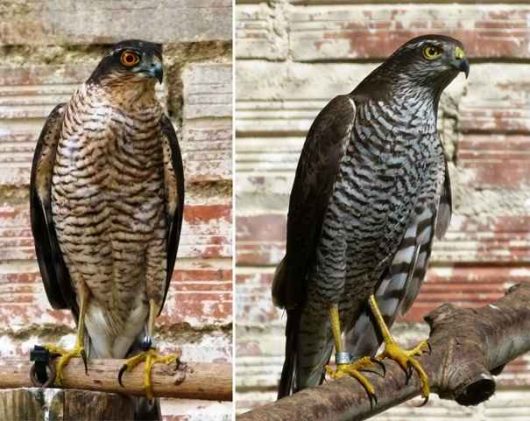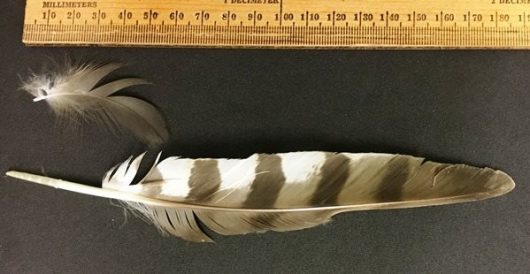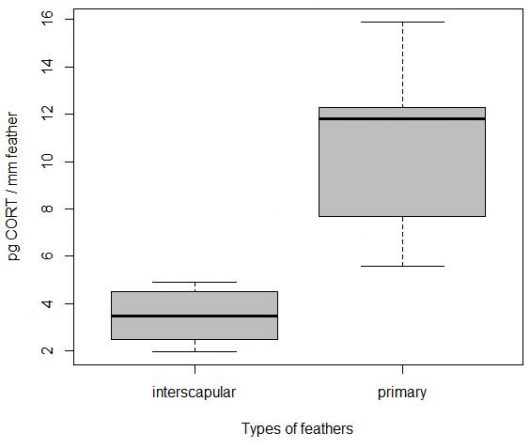Does feather corticosterone predict future survival?
LINKED PAPER
Relationship between feather corticosterone and subsequent health status and survival in wild Eurasian Sparrowhawk. Monclús, L., Carbajal, A., Tallo-Parra, Sabés-Alsina, M., O., Darwich, L., Molina-López, R.A., Lopez-Bejar, M. 2017. Journal of Ornithology. DOI: 10.1007/s10336-016-1424-5. VIEW
The importance of events occurring at a defined period of time may have future implications for birds’ fitness that can manifest on consecutive seasons (carry-over effects) (Harrison et al. 2011). One of the biggest challenges for ecologists is to obtain samples at that precise moment for predictive purposes, as it can be extremely difficult in free-living birds, particularly in migratory species. A relatively new method has been developed to solve this issue, using feathers, which allow us to obtain integrated and long-term levels of circulating corticosterone (CORT). This hormone is deposited into feathers (CORTf) throughout the moulting period, which may last from days to weeks depending on the type of feather. Given the relevant role of CORT as a regulator of the energy balance of individuals, maintaining homeostasis and promoting survival behaviours, measuring CORTf can supply integrative information of the global individual status. In addition, it is known that chronic increases of CORT levels, caused by chronic stress stimulus, may have detrimental consequences for an animal’s fitness, hence measuring CORTf levels can provide important ecophysiological information (Romero & Fairhurst 2016) and can be a potential tool for the monitoring of carry-over effects across seasons (Harms et al. 2015).
The importance of prognostic indicators at Wildlife Rehabilitation Centres
At present, several raptor species around the world are considered endangered as a consequence of anthropogenic disturbances. Wildlife Rehabilitation Centres represent one of the most widespread conservation means by which injured birds are treated and then released back into the wild. However, despite all best efforts, the outcome for more than the half of raptors admitted to these centres is euthanasia or natural death. Thus, assessing and developing non-invasive prognostic indicators is becoming an important goal for rehabilitation centres.
Developing and studying feather corticosterone as a promising prognostic tool
In this study, we investigated whether CORT deposited in feathers over the moulting period was related to subsequent mortality and health status in wild Eurasian Sparrowhawks, Accipiter nisus (Fig. 1), admitted to a Spanish Rehabilitation Centre. In addition, we assessed other potential sources of CORTf variation, such as sex, age, and feather type.

We sampled 34 Sparrowhawks, collecting interscapular feathers (from 4 to 6 feathers per individual), as this minimized the impact on the bird’s fitness in the event of release. However, in those birds that died or were euthanized for medical reasons, we also sampled primary flight feathers to compare CORTf levels with interscapular ones (Fig. 2).

We used plumage pattern to assess sex and age of individuals. Body condition was used as an indicator of individual health status, which was recorded at the time of individual admission. Specifically, we used pectoral muscle volume to estimate body condition and we classified individuals into three groups: good body condition, poor body condition and cachectic condition. We also monitored mortality throughout the study period. Sparrowhawks were admitted to the centre at different times during the non-moulting period (from November to May), thus the time gap between the moult and the individual admission to the centre was taken into account.
Our study provides the first published data on CORT from body covert feathers in Eurasian Sparrowhawks and serves to emphasize the need to analyze the same types of feather to avoid within-individual differences. We found that primary flight feathers displayed significantly higher CORTf levels compared to interscapular ones (Fig. 3). This CORTf difference can be explained as a consequence of the different feather growth rate. While body feathers moult after the breeding season, preceding winter stressors and migration, the moult of flight feathers can extend over two or more years and individuals can even arrest and delay their moulting when confronted with high energetic demands (Hardy et al. 2006, Gill 2007). Therefore, interscapular feathers may reflect steroid hormone levels over a more fixed and defined period of time allowing a better interpretation of the hormonal levels obtained. Also, as their removal is less invasive than that of primary flight feathers, the use of interscapular feathers is the most suitable when working with free-living birds.

Sex, age and the time gap between moult and the different bird admission dates were found not to influence CORTf values. In contrast, body condition was associated with CORTf variations. Birds with poor body condition showed higher CORTf levels than birds with good body condition. However, cachectic individuals showed low CORT levels (similar to good body condition individuals; Fig. 4). This similarity between good-condition birds and cachectic birds limits the utility of CORTf to predict body condition. However, this finding is of special interest as it suggests caution should be applied in assuming that only high CORT levels indicate low-quality individual conditions.

Finally, we observed that Sparrowhawks showing high CORT concentration also showed the highest probability of mortality (Fig. 5). Overall, this study concluded that combining information obtained from feathers and individual status recorded at the time of admission may allow the identification of individuals with a lower chance of survival, and thereby help considerably in establishing animal management priorities in wildlife rehabilitation centres.

References and further reading
Gill, F. 2007. Feathers. In: Ornithology, 3rd edn. New York: W.H. Freeman and Company, pp. 79–113.
Hardy, J., Crick, H., Wernham, C., Riley, H., Etheridge, B. & Thompson, D. 2006. Feathers. In: Raptors: a Field Guide for Surveys and Monitoring. Edinburgh: The Stationery Office, pp 243–280.
Harms, N.J., Legagneux, P., Gilchrist, H.G., Bety, J., Love, O.P., Forbes, M.R., Bortolotti, G.R. & Soos, C. 2015. Feather corticosterone reveals effect of moulting conditions in the autumn on subsequent reproductive output and survival in an Arctic migratory bird. Proc R Soc B 282: 20142085. VIEW
Harrison, X.A., Blount, J.D., Inger, R., Norris, D.R. & Bearhop, S. 2011. Carry-over effects as drivers of fitness differences in animals. J Anim Ecol 80: 4–18. VIEW
Romero, L.M. & Fairhurst, G.D. 2016. Measuring corticosterone in feathers: strengths, limitations, and suggestions for the future. Comp Biochem Physiol Part A Mol Integr Physiol 202: 112–122. VIEW
Image credit
Featured image: A dead Eurasian Sparrowhawk, Accipiter nisus | Ken Owen | CC BY-NC-ND 2.0
If you want to write about your research in #theBOUblog, then please see here.





